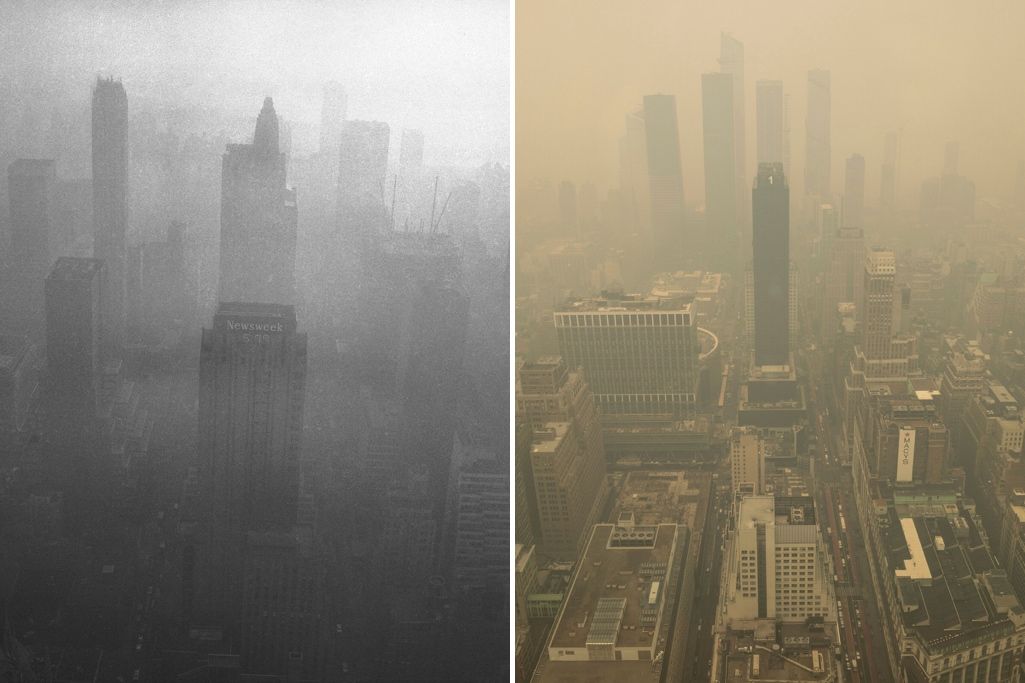Smoke in New York City evokes memories of 1966 ‘killer smog’
Listen 5 min Comment on this story Comment Gift Article Share
New York City’s skyscrapers were barely visible, engulfed in air so thick “you could feel the bits of smog sticking to your face,” Bill Burke recalled. While the hazy images bear a resemblance to Wednesday’s eerie orange skies as smoke from Canadian wildfires engulfs the city, Burke was recalling the “killer smog” of 1966, when a heavy cloud of sulfur dioxide and carbon monoxide enveloped New York.
That year, the toxic smog — stemming mostly from industrial residues and power plants using coal — hovered for some three days, starting on Thanksgiving and prompting a citywide alert that ordered all incinerators to close and utility companies to use natural gas. People with cardiovascular and respiratory problems were urged to stay inside during what’s now considered one of the worst air-pollution episodes and environmental disasters in modern U.S. history.
Burke, who was 11 in 1966, was in New York City for a family wedding. He recalls being holed up at the hotel most of the time because after just a few minutes outside, they would have to “wash pollution off your face and hands,” he said.
Advertisement
“I hadn’t seen anything like it in my life before or since,” he said.
Now, nearly 57 years later, the thick haze blanketing the city is bringing back memories of the days when the Mamas & the Papas and the Beatles were all the rage, Lyndon B. Johnson was president, and concerns about pollution and other environmental problems had just begun creeping into the public’s consciousness. About four years later, Congress passed the landmark Clean Air Act, meant to reduce air pollution.
Burke, who now lives in Rochester, N.Y., said that while there are parallels between the two events — “places and buildings that should be readily visible are obscured in the haze” — they’re not quite the same.
“Even as a child, I knew [the smog] was due to human activity,” he said, adding that this week’s haze reminded him of a trip he took to Wyoming in 2021, when Grand Teton National Park was obscured with smoke and a campfire smell lingered in the air.
“The air feels different in that it doesn’t require me to wash my face as soon as I get back indoors,” Burke added.
Christine Tailer said images out of New York City this week transported her to age 12, when she lived in a brownstone building with her family on the Lower East Side in 1966.
Advertisement
“The sky was so dusty, it’s what I remember most,” Tailer said. “You would look down the long streets of New York, and you would just see this dusty haze hanging over the city and couldn’t see off in the distance — a little bit like today.”
Tailer’s mom had suffered from respiratory problems since a bout with tuberculosis in the 1930s. Amid the toxic haze, she said, her mother’s health became a major concern — prompting her inventive father to take matters into his own hands.
Peter Tailer was a jack-of-all-trades buzzing with creativity, his daughter said. At 43, the self-employed patent attorney, photographer and building superintendent had dabbled with Stirling engines, crafted a four-seat bicycle for his family and sent hot-air balloons flying from the roof of their five-floor house.
So when the smog crept over the city and made it hard for his wife to breathe, Peter Tailer collected an assortment of parts to create an air-purifying machine he nicknamed “the Assemblage” — a name meant to be pronounced with a French accent “to make it fancy,” Tailer said.
Advertisement
Kept in a closed room, the Assemblage blew dirty air into a box about the size of a dining table that had water circulating inside of it. A pump pushed the water toward the top and made it shower down through a screen. The purified air would then flow through that trickling water and into a fan that forced it back out into the room.
“There was no air conditioning, so the air from outside was the air we breathed inside,” Tailer said. “So by doing this, we all think he kind of saved my mother.”
Both Peter and his wife, Geraldine, would go on to live long and happy lives, she added.
The smog that filled the city that holiday weekend proved fatal for some. A 1968 report from the U.S. Department of Health said that between Nov. 24 and 30 in 1966, researchers found “an increase in death rate of approximately 24 deaths per day.” In 1967, the New York Times reported the smog had killed 168 people — and scientists worried about its lingering effects on survivors.
Advertisement
“Lung damage suffered during the period would probably be a contributing factor in diseases suffered by New Yorkers for years to come,” a scientist told the Times.
The smoggy episode became a wake-up call, prompting activists and officials to push for policies that control air pollution — resulting in the passage of the Air Quality Act in 1967 and, in 1970, the Clean Air Act, as well as the founding of the U.S. Environmental Protection Agency.
Satellite imagery captured May 20 showed a smoke swirl arriving in the central U.S. (Video: (CSU/CIRA & NOAA))
Since then, air quality has improved in American cities, but climate change has prompted concerns about carbon emissions — and the EPA’s ability to curb them following a 2022 Supreme Court decision. The court limited the EPA’s ability to stem greenhouse gas emissions after deciding some federal regulations had exceeded the agency’s authority.
“Funny that this event directly precipitated the Clean Air Act and now we’re experiencing something similar while the Clean Air Act has since been gutted,” Dwight Rhinosoros, of the Eat the Rich podcast, tweeted alongside a 1966 photo of New York City blanketed in smog.
GiftOutline Gift Article
Source: The Washington Post


